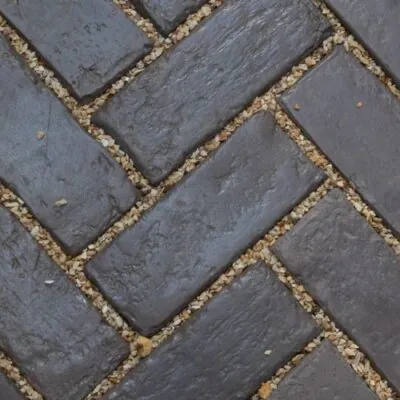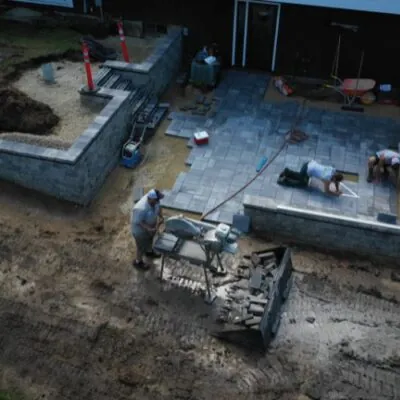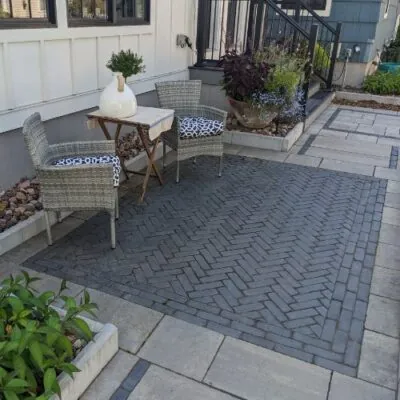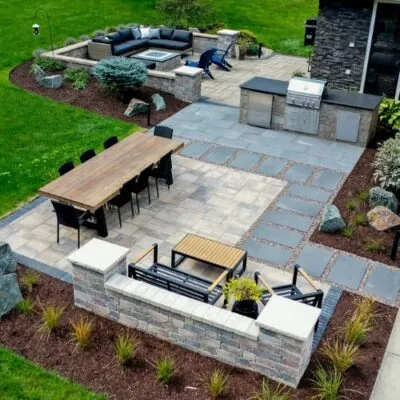
Paver Patio Installation: Best Practices
Landscape Design and Installation: Paver Patio Best Practices
A paver patio is a fantastic way to enhance your outdoor living space, providing both beauty and functionality. Whether you’re creating a cozy backyard retreat or an entertainment area, a well-installed patio can significantly increase your property’s value. However, in Wisconsin’s unique climate—with its cold winters and frequent freeze-thaw cycles—it’s essential to follow best practices to ensure your patio stands the test of time. At Carrington Lawn & Landscape, we specialize in landscape design and installation and are here to guide you through the process.
The Foundation: Ground Preparation and Base Layers
The longevity of a paver patio depends heavily on proper ground preparation. Without a stable foundation, patios are prone to shifting, sinking, and cracking over time.
 Excavation and Base Installation
Excavation and Base Installation
To create a solid foundation, the ground must first be excavated to the proper depth. For most patios, this means digging at least 9-12 inches below the finished grade to allow space for the base materials and pavers. In areas with clay-heavy soil, deeper excavation may be required to improve drainage and prevent heaving during winter.
Instead of traditional compacted road gravel, modern best practices favor an open-graded base system that enhances drainage and stability. This consists of:
- 4-6 inches of one-inch clear stone, which allows water to pass through without trapping moisture. Additional thickness is required for vehicular paver applications.
- A 1-inch choker layer of 3/8-inch clear stone, helps create a smooth and stable setting bed for the pavers.
- Compaction in 2-inch layers is necessary if using a standard plate compactor (larger compactors can compact thicker layers) to ensure uniform stability and prevent settling over time.
- A stabilizing geotextile material installed beneath the paver base helps disperse point loading and prevent setting. This is the same product used in highway and road construction. Additional layers should be installed within the clear stone base depending on the total base depth, soil type, and drainage conditions.
Ensuring Proper Drainage
Drainage is a key consideration in any patio installation, particularly in climates with frequent freeze-thaw cycles. Without proper drainage, water can accumulate, leading to paver displacement and deterioration. To prevent this, patios should be designed with:
- A 2% slope to direct water away from structures.
- Permeable base materials that allow water to drain effectively rather than pool beneath the pavers.
- Supplementary drainage solutions, such as catch basins, infiltration pits, buried drainage pipes, or dry creek beds, to manage excess water in areas prone to pooling.
Selecting and Installing the Pavers
Not all pavers are created equal, and selecting high-quality materials ensures durability in Wisconsin’s demanding climate. Concrete pavers with higher PSI ratings are an ideal choice in areas with freeze-thaw cycles as they are less prone to cracking and moisture absorption. Concrete products from manufacturers such as Unilock, Belgard, or Rochester offer superior performance over less expensive options from home improvement stores.

Once the base is prepared, pavers are carefully laid in the desired pattern. To maintain long-term stability:
- Pavers must be properly aligned and compacted into the setting bed.
- Jointing sand, preferably polymeric sand, is swept into the gaps to prevent weed growth and enhance paver interlock.
- A plate compactor is used to firmly set the pavers in place, creating a structurally sound surface. Rolling compactors should be used for larger paver types or pavers with refined finished surfaces.
Permeable Pavers for Enhanced Performance
For homeowners seeking improved drainage and reduced ice buildup in winter, permeable paver systems are an excellent option. These systems, when installed over an open-graded base, allow water to filter through rather than collect on the surface, reducing the risk of ice formation and providing better year-round performance.
The Role of Edge Restraints
Edge restraints are essential to maintaining the integrity of a paver patio. Without proper edging, pavers can shift outward over time, leading to an uneven surface. Using plastic, aluminum, concrete, or wet-set edge restraints helps secure the patio’s structure and prevents long-term movement.
Why Choose Carrington Lawn & Landscape?
At Carrington Lawn & Landscape, we take pride in providing expert landscape design and installation services tailored to Wisconsin’s unique climate. Our team has years of experience creating durable, stunning paver patios that enhance outdoor spaces and add lasting value to homes.
If you’re considering a paver patio for your property, let us handle the hard work. From proper ground preparation to expert installation, we ensure a high-quality finish that will withstand the elements for years to come.
Contact Carrington Lawn & Landscape today to schedule a consultation and start designing your dream outdoor space!


 Excavation and Base Installation
Excavation and Base Installation
